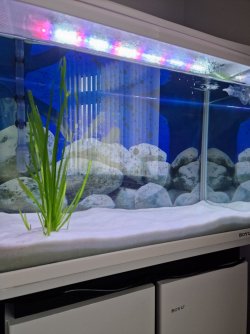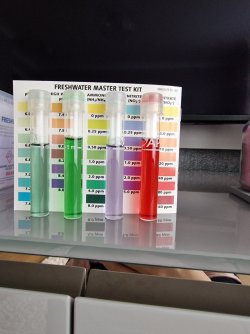Brookes9879
New Member
Hi,
So I started my fishless cycle 19th December however I changed my built in filter to an external filter on the 13th Jan, my nitrites were down to 0 and so was my ammonia but I can't get my PH to go up even with one big water change and then several smaller ones daily the PH remains at 6.8 which I'm not happy with for my axolotl, my nitrates also have gone down but are still at just over 40ppm, as my nitrite and ammonia was 0 I added the full dose of ammonia last night and now when testing my nitrites have gone back up to 0.25ppm with an ammonia reading of 2.0ppm so it's obviously not ready yet to house my axolotl.
I'm so stumped on my PH not raising, I've tested the water out of the tap and also when it's stood for 24/48 hours and it reads between 7.2/7.6 (ideal for my axolotl) the only thing I can think of is that I have a plant in my aquarium it is not decaying and looks healthy. Should I just take out the plant? I've also moved my filter outlet hose so that it breaks up the surface of the water for my oxygen/bubbles.
(I use seachem prime to condition the water before adding it to the tank and Dr Timms ammonia and an API masterkit tester and aps 150 external filter)
ive added a picture of the plant i have and also my water test readings
Can someone please help.
Thank you in advance
So I started my fishless cycle 19th December however I changed my built in filter to an external filter on the 13th Jan, my nitrites were down to 0 and so was my ammonia but I can't get my PH to go up even with one big water change and then several smaller ones daily the PH remains at 6.8 which I'm not happy with for my axolotl, my nitrates also have gone down but are still at just over 40ppm, as my nitrite and ammonia was 0 I added the full dose of ammonia last night and now when testing my nitrites have gone back up to 0.25ppm with an ammonia reading of 2.0ppm so it's obviously not ready yet to house my axolotl.
I'm so stumped on my PH not raising, I've tested the water out of the tap and also when it's stood for 24/48 hours and it reads between 7.2/7.6 (ideal for my axolotl) the only thing I can think of is that I have a plant in my aquarium it is not decaying and looks healthy. Should I just take out the plant? I've also moved my filter outlet hose so that it breaks up the surface of the water for my oxygen/bubbles.
(I use seachem prime to condition the water before adding it to the tank and Dr Timms ammonia and an API masterkit tester and aps 150 external filter)
ive added a picture of the plant i have and also my water test readings
Can someone please help.
Thank you in advance
Attachments
Last edited:



